UPDATE: In case you missed the announcement, the route for the 2013 3 Peaks Challenge has been changed. Click here to read about what you can expect from the updated route.
On the weekend of March 10 2013, thousands of cyclists will converge on the Falls Creek Alpine Resort to take part in one of the hardest single-day rides in Australia: Bicycle Network’s 3 Peaks Challenge.
It’s a tough ride regardless of your fitness level, and if it’s your first time tackling the event, the 235km course with 4,300m of climbing will be daunting to say the least.
So what’s the best way of approaching the 3 Peaks Challenge? And what can you expect from the various sections of the ride?
The lead-up
Before you tackle the 3 Peaks Challenge it’s worth completing at least one ride that’s close to 200km long and that has plenty of climbing. Take this ride for example — it’s a very tough 175km course that includes 4,000m of climbing and three lengthy climbs: Reefton Spur (20km of climbing), Lake Mountain (21km of climbing) and Mt. Donna Buang (17km of climbing).
The fatigue you will feel on that final slog up Mt. Donna Buang is similar to what you’ll feel on the Back of Falls climb during 3 Peaks. In my opinion, if you can get through this ride in training, you can get through 3 Peaks.
In addition to that final long ride, it’s important to give yourself enough time to taper before getting to Falls Creek. There’s basically no value in doing long, hard training rides in the week before 3 Peaks so do your hardest training ride two weeks before the event.
It’s also worth carbo-loading for two or three days before 3 Peaks to ensure you hit the start line with your glycogen stores topped right up. Make sure you’re also drinking lots of water in the days before the ride.
What to bring
Check out the Bicycle Network Victoria website for a list of recommended and required items.
In addition, I’d recommend investing in a compact crankset (34-tooth small chainring) and/or a rear cluster that has a 28-tooth gear, or bigger. These extra gears will allow you to spin up the many steep ramps you’ll come across during the day. Spinning will mean you fatigue slower than you would if you were grinding away in a big gear.
At the start
As you line up at the start line on March 10, there’s every chance you’ll be nervous. You’ve got a long, hard day ahead of you and the climbs only get harder as the day goes on. But there’s a way you can make the task ahead seem more manageable.
Rather than approaching the day as one, 235km effort, break it down into more approachable, bite-sized chunks. When you’re at the start line, don’t aim for the end of the course, aim for the bottom of Tawonga Gap. When you get there, give yourself a pat on the back, refocus, then aim for the top of the first climb.
Approaching the ride as a series of smaller efforts can really help to turn the epic into something a little more manageable. See below for the ride’s sections, as I see them.
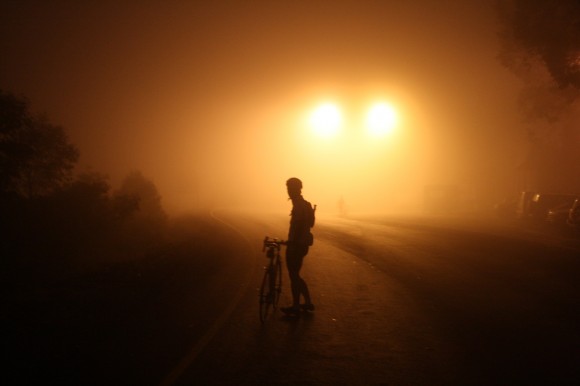
Section 1: Falls Creek to Tawonga South
Distance: 34km
The day starts with the long descent from Falls Creek to Mt. Beauty. With nervous energy and adrenaline pumping through your body, you might be inclined to push hard on the descent. Don’t. You’re better off just turning your legs over gently, getting warmed up and making sure you get through the descent safely.
After 13km of descending you’ll cross the Kiewa River and for the next 13km or so the road is quite undulating. Take it easy on the descents and just spin comfortably up the short climbs. After roughly 25km you’ll reach a left-hand bend after which it’s another 4km downhill into Mt. Beauty. Enjoy it!
From Mt. Beauty to Tawonga South — and the start of the first proper climb — is largely uphill. Again, use these early kilometres to get your legs warmed up and to find a comfortable rhythm. No use burning yourself out before you’ve even ticked the first peak off the list.
Section 2: Tawonga Gap climb (peak #1)
Distance: 7.6km
After 34km you’ll turn left onto the Tawonga Gap Road and from there it’s 7.6km to the top of the first of the 3 Peaks. At an average gradient of around 6% it’s a tough little climb and with virtually no flatter sections to speak of, it’s important to find a comfortable rhythm early.
While the gradient is quite consistent throughout, there are a number of hairpin bends where the gradient increases quite noticeably. Two such corners can be found in the first 3km of the climb.
It can be fun tackling this climb in a small group but make sure you’re climbing at a pace that’s comfortable for you. There’s no point putting yourself in the red just to keep up with other riders if it means you’ll hit the wall within the first 50km of the ride. Remember, this is the first (and easiest!) of the 3 Peaks so make sure you’re saving plenty of energy!
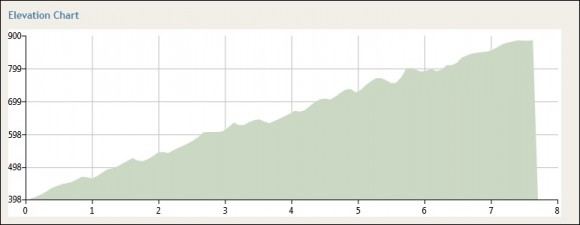
There’s a small rest stop at the Tawonga Gap so once you summit the climb you can take the opportunity to refill your bottles and/or grab something to eat. Of course, if you’re feeling good you can push into the next section of the course without stopping. Either way, make sure you give yourself a little pat on the back as you start to roll toward Germantown.
One down, two to go.
For more information about the Tawonga Gap climb, visit this page.
Section 3: Tawonga Gap to Harrietville
Distance: 33km
The descent from the Tawonga Gap to the Great Alpine Road is one of the most enjoyable in the Victorian Alps. Unlike most roads in the Alps, corners on this particular descent are nicely cambered, giving you a nice, fast and flowing descent.
Enjoy yourself as you bomb towards Germantown but remember to stay safe, and look out for other riders around you. The descent flattens off somewhat after about 6km of descending (roughly 47km into the ride) but you’ll still be able to maintain a high speed in the next 8km.
After 55km you’ll reach the small community of Germantown and the Great Alpine Road. From here you’ll take a left turn and then it’s roughly 20km to Harrietville and the foot of Mt. Hotham along one of the very few sections of flat road on the ride.
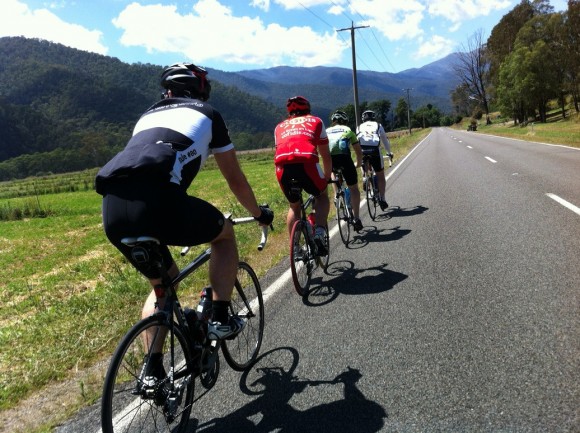
The Tawonga Gap climb is likely to have split any groups that formed in the first section of the ride, and chances are you’ll arrive at Germantown with only a handful of riders around you. If there’s a group nearby, it’s well worth joining in to save as much energy as you can before the Mt. Hotham climb.
It’s probably even worth waiting a few minutes in Germantown or soft-pedalling towards Harrietville in order to get swept up by a group. You’ll save a lot of energy sitting in the bunch — energy that you’ll need when you start climbing Mt. Hotham. But don’t be a wheelsucker — get out into the wind and do your turn — the whole group benefits if everyone’s helping out.
As you get close to Harrietville you’ll see Mt. Hotham looming large ahead of you. Before you go and tackle the beast, it could be worth filling your bottles and having something to eat at the Harrietville rest stop.
Section 4: Mt. Hotham climb (peak #2)
Distance: 30km
With your bottles filled, your pockets full of food and after you’ve psyched yourself up, it’s time to take on the epic Mt. Hotham. By this point you will have ridden 74km and it’s another 30km until you reach the top of the climb.
It’s a long, challenging climb with some very steep ramps but just as you can break down the 3 Peaks Challenge into sections, the Mt. Hotham climb can be broken up. The first 11km out of Harrietville are very consistent with an average gradient of around 6% and only two steeper sections to contend with: the very first corner of the climb and The Meg — a 300m-long ramp that nudges 10%.
Be sure not to go too hard too early on Mt. Hotham — it’s a very long climb and one that will make you pay if you go too deep.
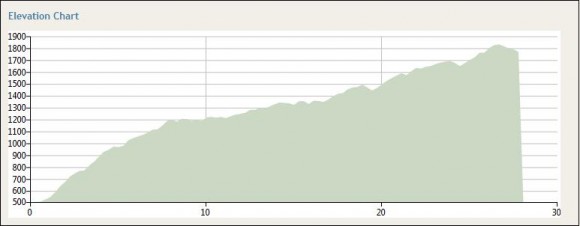
After 11km of climbing (and 85km into the ride) you’ll hit the second part of the Mt. Hotham climb — a 9km false-flat. While this section is gradually uphill, it’s considerably easier than the first (and last!) section of the climb. Use these 9km to catch your breath and to prepare yourself for the final part of the climb.
There’s a rest stop just as the false-flat ends so feel free to grab a drink and/or some food as you pass by. From this point, roughly 94km into the ride, you’re into the final third of the climb — the toughest section.
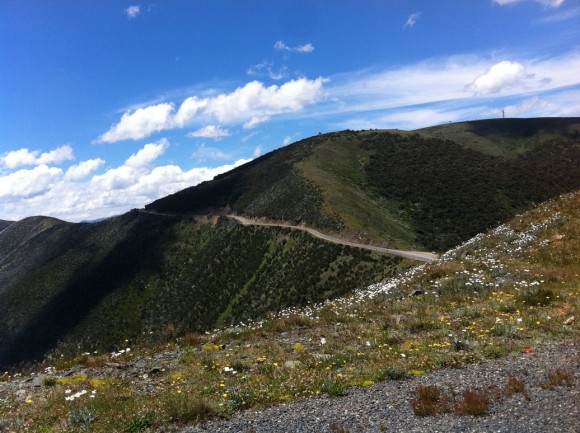
While there are two very fast descents in this 10km section (be careful!) you’ll also come across the two hardest ramps of the entire climb: CRB Hill (1.1km @ 10%) and the Diamantina (1.4km @ 9%). These sections are painful even on fresh legs so give yourself a pat on the back as you crest each of them.
As mentioned, Mt. Hotham is a very tough climb but it also happens to be one of the most picturesque pieces of road in Victoria. Be sure to enjoy yourself while you’re climbing — the views in the final third of the climb are simply sensational.
Oh, and make sure you celebrate just a little bit as you reach the top of the climb.
Two down, one to go.
For more information about the Mt. Hotham climb, visit this page.
Section 5: Mt. Hotham to Dinner Plain
Distance: 11km
As you roll into Hotham Heights you will have completed 104km — nearly halfway there. Your reward for conquering Mt. Hotham is the lunch that’s awaiting you 11km down the road in Dinner Plain. It’s mostly downhill from Hotham Heights to the lunch stop but it’s worth expecting a few short rises as well.
Once you’re at Dinner Plain, 115km in, it can be tempting to sit down and relax for an hour or more but your best bet is to eat and get moving quite quickly. There’s still a long way to go and if you rest for too long your legs will assume it’s time to start the recovery process, making it harder to get going.
Section 6: Dinner Plain to Omeo
Distance: 43km
While the ride from Dinner Plain to Omeo is mostly downhill, don’t be fooled into thinking you can freewheel all the way down. Sure, there are several sections of sustained descending, but there are also quite a few flat kilometres and more than a couple climbs. Also bear in mind that the road surface is quite rough so you won’t get as much value for your pedal strokes here as you will elsewhere on the ride.
After 136km of riding, and after one of the day’s fastest descents, you’ll cross the Victoria River and pass the community of Cobrunga. The next 10km are quite undulating but after 146km you’ll hit a nasty 3km stretch which is mostly uphill with a couple of steep ramps. Get through this section though and you can enjoy the terrific ~9km descent into Omeo.
There’s another rest stop here in Omeo, 158km into the ride, and it’s worth stocking up on food and water before pushing on.
Section 7: Omeo to WTF Corner
Distance: 40km
When you leave Omeo you’ll ‘only’ have 75km to go in the 3 Peaks Challenge. And even though you’ve still got the Back of Falls climb to go, it’s best to concentrate on the next 40km and worry about the climb when you get there.
As it turns out, the 40km after Omeo are among the most picturesque of the entire day. After 166km of riding you’ll start climbing from farmland up to a truly stunning section of road that runs alongside Big River. The climb is more than 4km long and it can knock you around if you’re not expecting it.
As with climbs earlier in the day, there’s no real point pushing it up this rise as you’ve still got 65km and the Back of Falls climb to go. Instead, spin your way up at a nice high cadence (80-90RPM) and save as much energy as you can.
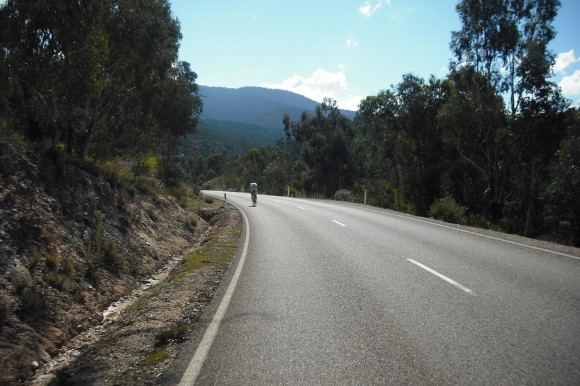
When you reach the top of the climb, 170km into the ride, it’s just 30km until the start of the final climb of the day. This section of the road is largely flat with only a couple of short rises and descents, and you can maintain a decent speed as you tick off the kilometres. Even if you’re starting to feel anxious about the final climb, try to take in your surroundings as much as possible — it’s a stunning part of the world and a real privilege to ride through there.
After 186km you’ll reach the Anglers Rest feed zone. Stop briefly to fill up on food and/or drink if you like, but get moving pretty quickly — you’ll want to push on before your legs realise they’ve got an opportunity to rest.
After another 13km of very scenic riding you’ll reach an intersection known unofficially as WTF Corner — an extremely steep ramp that starts the final climb of the day.
Section 8: Back of Falls climb
Distance: 23km
Let’s be totally honest — this climb is going to hurt. It’s a tough climb even on fresh legs but with 200km of riding already behind you, it’s going to be a real challenge. But, as with 3 Peaks overall — and as with Mt. Hotham — the Back of Falls climb can be broken down into manageable chunks.
The first few hundred metres of the climb average close to 10% making the start of this climb the hardest part by far. And sadly, there’s very little respite for the first 9km of the climb which rises at an average gradient of close to 9%. The rough surface makes this section even harder than it might otherwise be and regardless of your gearing, you’ll be wishing for an extra couple of gears.
But after those 9km — after roughly 207km of riding — things start to ease off a bit. That’s not to say it’s easy, but it’s certainly a lot easier than those first 9km from WTF Corner. Even better, it’s only another 3km to Trapyard Gap — the final rest stop of the ride.
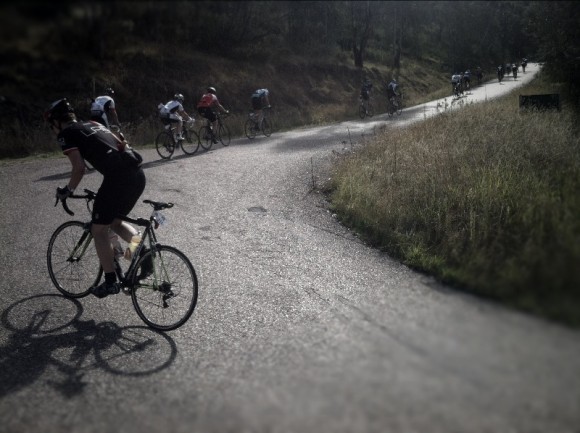
Quite simply, if you’ve made it this far, you can make it to the end. Sure, there’s still a bit of climbing to go — 12km or so — but the worst is well and truly behind you and besides, you’re so close to the end.
After roughly 222km of riding — and about 23km of climbing from WTF Corner — you’ll reach a crest in the road. For all intents and purposes, this is the top of the final climb.
It’s time to party.
For more information about the Back of Falls climb, visit this page.
Section 9: Falls Creek Plateau to Falls Creek (peak #3)
Distance: 13km
Once you’ve crested the Back of Falls climb there are still a couple of short rises left to conquer but the sustained climbing is behind you. Better than that, you’re about to catch a glimpse of the Rocky Valley Storage Dam and the Falls Creek village — the end is near and damn does it feel good.
The remaining 13km to Falls Creek are largely downhill and any pain you were feeling on the Back of Falls will quickly be forgotten as you push towards the finish.
As you descend those twisting final kilometres, take a moment to soak it all in — the cool mountain air, the fatigue in your legs, the feeling of relief and satisfaction. Congratulations, you’ve just conquered one of the toughest one-day challenge rides in Australia!
Bonus: pushing for time
If just finishing the 3 Peaks Challenge isn’t enough for you and/or you’ve done it before, you can always set yourself an additional challenge: finishing the ride in a certain amount of time.
The folks at Bicycle Network Victoria have made this challenge a little easier for you by having members of the 3 Peaks Pro Team set the pace for various time cut-offs. Please note that the times below are total cumulative time — i.e. breaks are included.
- Nick Mitchell: 8 hours
- Peter English: 9 hours
- Mark Guirguis: 9.5 hours
- Alison McCormack: 10 hours
- Kevin Russell: 10.5 hours
Regardless of the target you set yourself, you can cut your total time by reducing the number of breaks you take. In addition, ensure that the breaks you take don’t last any longer than they need to. For a bit of context, 3 Peaks Pro Team member Peter English apparently spent less than 10 minutes off the bike during last year’s ride.
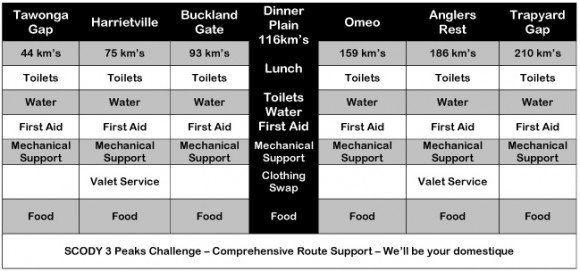
Of course, shortening your breaks and reducing the number of times you stop might seem easy now but on the day you might well feel like you need a longer break.
Regardless of how you decide to approach it, remember that even just completing the 3 Peaks Challenge is a fantastic effort and one that you should be proud of!
Have you completed 3 Peaks before? If so, what other tips would you offer first-time riders? And if you’re a first time rider, what else would you like to know about the day? Leave your questions below and I (or someone else) will answer them for you.
Thanks to Emma Bolger and the Bicycle Network Victoria team for inviting me up to Falls Creek to attempt the 3 Peaks Challenge once more. I’m very much looking forward to the ride and grateful for their support.

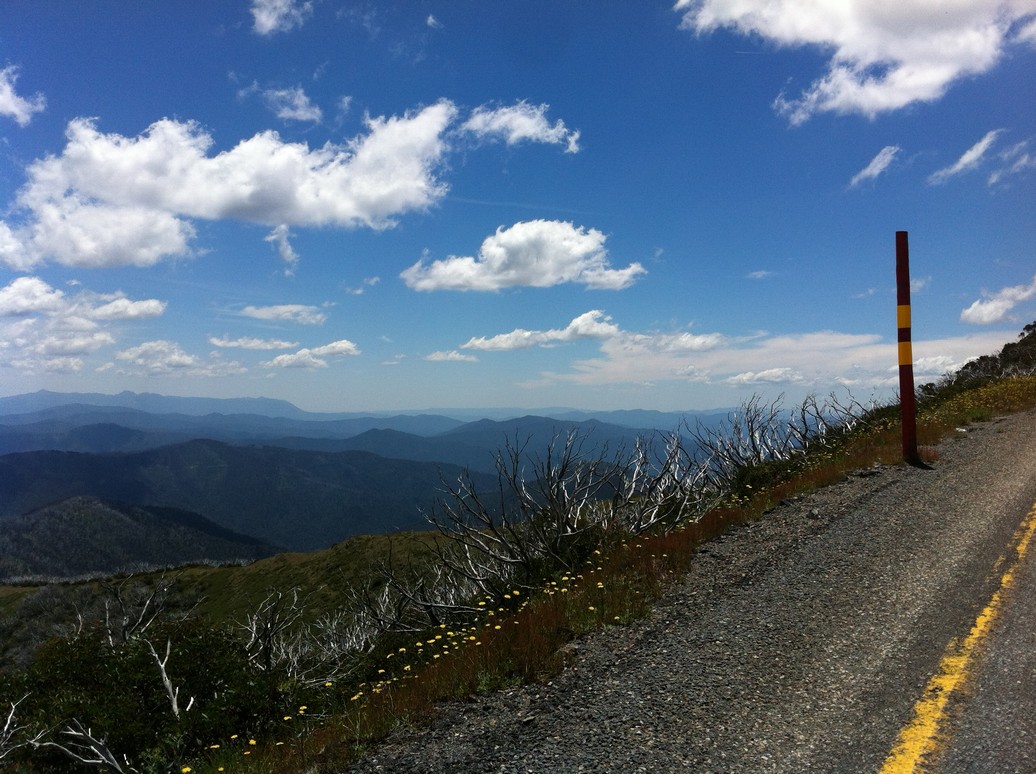
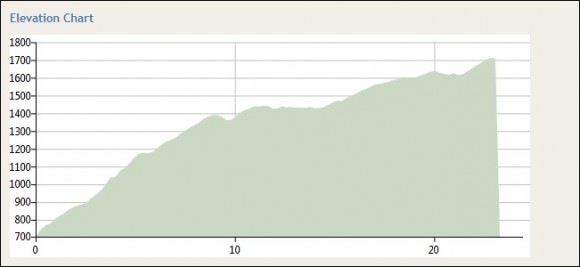
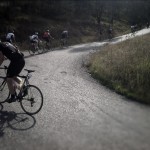
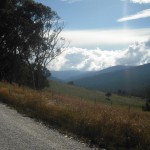
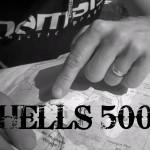
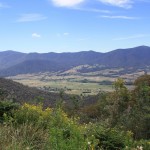
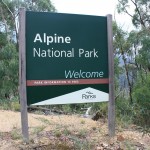
I would like to know what the age of the oldest rider in the 3 peaks
Brilliant write-up. I did my first Peaks Challenge yesterday and this guide got me through it. I just focused on getting through each section, trying not to think too fat ahead. You’re a gem! I found Mount Hotham the toughest of the three climbs, the knowledge that a coke was waiting for at Trapyard Gap lured me up WTF Corner and onwards. Thank you for this guide!
I think everyone that enters this event can ride a bike and has trained to finish within their “own” timeframe . But where we can all come unstuck is in the “1% ers”.
1. Nutrition…..get this right and eliminate the risk of “running on empty”
2. Weather….. prepare for extreme cold and heat, and all in between.
Hi Matt
I wonder if you could comment on road surface quality for 3 Peaks. I am thinking about tyre selection. Yes, there had to be at least one serious nerd out there! I’m thinking of trying 25mm tyres at 80-90PSI rather than the 23mm tyres I usually ride to try to reduce fatigue generated by road feedback/vibration. There seems to be a trend towards 25mm tyres – higher comfort and lower rolling resistance on less than perfect tarmac. I intend to ride the new tyres for about 7 days before the ride.
Thanks in advance
Craig
Hi Craig, in all honesty I wouldn’t bother with 25mm tyres. I’ve done the course twice on 23mm and didn’t have any problems at all. The only rough sections is the Back of Falls climb and that’s actually fine now. It was extremely rough in the first year after they sealed the road, but nowadays it’s totally doable on 23mm tyres. So yep, don’t worry about the 25mm tyres. 🙂
I swear by 25mm tyres – both clincher and tubular.
You lose nothing in speed but gain in puncture resistance and comfort. (Particular on carbon wheels)
I love the GP4000S for normal riding.
(4Season or Gatorskin are better in the city for commuting)
This will be my second 3 Peaks and apart from all of the fantastic advice from Matt I can only add – stay strong. I was right on the 13 hours and was only passed by the Lanterne Rouge at the back of Falls. It’s an epic day – get your nutrition right, stay hydrated as it can get warm in the valleys and near Omeo (32 degrees last year according to my Garmin). Once you get to Anglers Rest, you can make it – the back of Falls hurts, but I just kept telling myself – I came here to complete this ride and I will. So to all of you first timers – well done, awesome courage and attitude. This is a spectacular ride and the Hotham climb, Big River and Falls Plateau are all incredibly beautiful places to cycle – you will have an amazing day.
Regan,
Thanks for your email, do you mind if I ask what level of rider you are and what sort of training you had undertaken to hit the 13 hour mark? Im taking it on for the first time and am really nervous as I have never tired anything like this before. I have been hitting 250 – 300kms per week for the last 5 or so weeks and have taken on Arthurs Seat and the Dandenongs as part of the training so hopefully it will help me get there.
Look forward to hearing from you.
Hi Matt,
I reckon you’d call me a seasoned rider. I can comfortably ride 100 km plus at will. I’m heavy – 100+ kgs so the hills are tough. I recently completed the amended Alpine Classic 200 as part of my prep – 3 repeats of Buffalo in 1 day. The 3 peaks is a seriously big day and I can only endorse Matt De Neef’s advice to do approx 200 km in 1 day with some serious climbing (2000m +) as part of your training. I’m heading out to complete the Demon’s Double this Sunday (24/2/13) if you’re keen. The amount of km you are riding will be awesome for endurance, but you do need serious hill climbing muscle memory for one reason – the back of falls. The first 9 km are simply brutal. I hope this has helped in some way and not made you more nervous 🙂
Thanks Regan,
I can certainly knock over a 100km’s in a session and have been doing a 150km weekend ride as standard although my largest climb is 1,300 meters over 160km or 1,200 over 65km so i think i will do a few loops through the Dandenongs through the week to try and get to the 2,000 meters. thanks very much for your reply and maybe see on the climb!! Best of luck.
Matt
This is my first 3 peaks and I am just about to invest in some rain protection and only have the budget to get a vest or a full length jacket. What would you recommend, the wind breaker/water proof vest or the full jacket?
Full jacket, so long as it’s light, foldable and waterproof. 🙂
This will be my first 3 peaks also this year.
I became aware of this great challenge about 8 months ago…and can quite honestly say it has been on my mind every day!!!
I am so looking forward to the ride and have been sticking to a rigid 12 week training program in which i am hoping to crack the 10 hrs…maybe hopeful thinking?!?!
I have climbed all three of the climbs separately & thoroughly enjoyed them but am sure stringing them all together on the same day will be epic.
Thanks so much for the info in this article & i will definitely be taking all the advice.
Great website too….have found it a great tool to get into this wonderful sport of which i have been doing now for all of one year!!!
cheers…
Thanks Chris! Best of luck with the ride! 🙂
Also riding 3 peaks for the first time. Partly down to riding friends, but your combination of enthusiasm and facts about climbs and climbing has been a big part of my decision and shaped my training. I might or might not make it, but thanks for your site.
Thanks Andrew. 🙂
Just curious, is there any word on how the fires in harrietville, hotham heights etc are going to impact the event. Find it hard to believe they will have them safe in the next few weeks, unless of course there is a few days of constant rain. Great article by the way, wish their was something like this out on the net a few years ago when I last rode.
Not sure Dave, but a good question. I’m sure Bicycle Network Victoria will keep us posted. And thanks re: the article. That’s really nice to hear. 🙂
I’d like to echo Cam’s question – essential for nutrition and water planning. I’d be interested in the 10 and 11hr pacers. Cheers
Difficult question to answer. My first time this year, so I did have a look at times on Strava
I think the pace setters were (from Strava you will be able to see where they rested and for how long)
9 Hr Pace, Peter English, 8:40 Total, 8:25 Moving
http://app.strava.com/activities/39566769
10.5 Hr Pace, Kevin Russell, 10:34 Total, 9:10 Moving
http://app.strava.com/activities/5097519
Lanterne Rouge 13 Hr Pace, Ben Douglas, 13:02 Total, 9:45 Moving
http://app.strava.com/activities/5143369
Wouldn’t recommend trying to match a pace. Everyone has different strengths and weaknesses across flats, climbs, descents, etc and hence ‘pace’ setters can’t really set a pace for everyone (a 13hr rider would moving for longer than the Lanterne Rouge).
The Ride Guide has times for 8 through to 13hrs. However be careful because while some are generous others would be difficult to achieve e.g. the Guide has Dinner Plains to Omeo as 1:05 for the 13hrs pace and the best time by anyone on Strava is 1:05 (that includes riders who can do the course in less than 8hrs).
Lots of different things can happen on the day so any plan needs to be flexible.
Thanks for that – and echo those thoughts re: different strengths….last year I seemed to be always stuck between bunches…so will be trying to find that right bunch this year!!
Good luck to all – my only other tip – enjoy those last km’s once you crest Falls and see the reservoir….it’s an amazing feeling knowing that you are going to make it!!
Enjoy and thanks again for the article – all rings true!!
The lantern rouge was only moving for 9:45 but there won’t be many 13 hour riders who will take 3:15 in breaks. He passed me twice (I caught him at the breaks) but was riding alone each time. he was riding too fast for me to keep up with him.
My main tip would be water. One 750ml bottle per hour. That’s 13 bottles for me. It’s a lot but your performance will suffer badly if you’re dehydrated and it’s hard to feel it at the time.
Are you able to advise how many stops / which checkpoints or how long overall some of the pacers would stop for – i.e. say the 10hr pace group? Might help with planning….at least in theory!
Can’t wait for it again!
Im taking on this challange for the first time in 2013 and I have to say I am nervous beyond belief!! I originally had 3 ‘partners’ to join me on the day but due to issues largely related to heart strings I’m going to be taking on this challange on my own. Hopefully my training will see me sneak in under the 13 hour time limit – either that or you will see guy in tears on the side of the road!!
Good luck to everyone who is participating!
And to you Matt!
Agree with all the above. If you are a slow rider like me, make sure you have enough battery left to run lights as the marshalls were threatening to remove cyclists for riding in low light without bike lights – imagine being taken off the course after 225km because you did not have an operating light!!
Great event – enjoy (retrospectively!!)
Carry Panadol, for your arse. It’s going to hurt.
Via suppository no doubt… how French…;0)
I’m quite pumped to be attempting my third 3 peaks this year. 2010 I abandoned with hypothermia due to the weather. 2011 I finished in about 10 hours riding time but only just within the time limit due to various stops. This year I am aiming for <10 hours. Will be close based on training form.
Here are the things I'm doing differently based on this experience. Agree with all the points above btw: this stuff is incremental.
Ride buddies:
I love my mates but waiting for them / having them wait for me can cost an hour over a ride like this. We will therefore break into smaller groups with aligned capabilities. Makes the stories better at the end of the day btw!
Nutrition
I got so sick of sweet food over the day. I've since taken to Vegemite sangas post 150km. Be careful not to get any on the white bar tape though! Also a can of coke (yes I know what I said about sweet things) just before wtf corner was the best thing ever!
Bike
I can ride the back of falls with a 39/28. But it sucked. I now have a compact.
Ill also stick a small bottle of chain lube in my tool bag. After riding through rain like I had to both times, the sound of a dry grinding chain tortured my mind on the slow roads after omeo.
Clothing
This has all been mentioned before: I reckon I would have finished 2010 if I had dry clothes at dinner plain. Use this service. Include some chamois cream in the bag you send.
I now swear by Marino wool for socks and under shirt on this ride. I got saturated and dried through twice between falls creek and lunch on my successful attempt but was warn and kept going.
Have fun! For what it's worth: I found the 4km of hills after omeo the hardest. Maybe I hadn't been expecting them: maybe I was low on energy, but some food and some laughs at this point helped me to finish.
For the slower riders (like me) what I noticed last year was riding between 7pm and 8pm to the finish it got quite dark. I tried to take my sunglasses off to lighten things up and the cold alpine air caused my eyes to water, so I had to choose between wearing sunglasses with limited vision or fighting against watering eyes. I chose the former. This year I have invetsed in new sunglasses that adjust to the darkness.
Great article,
You didn’t mention weather.
Last year was perfect with great sunshine and a perfect day for the ride but the year before was all over the place, raining when we started, 35 deg in the valleys and wind and rain at the top of Hotham and Falls Creek!
You need to keep in mind that you are getting some serious altitude and that the weather can and will change quickly.
Make sure that you pack two sets of everything so that you can put one set into your pack to pick up at Dinner Plains at lunch if you need to change because you are wet.
Last year I wore the same kit all day with the addition of arm warmers on the Falls creek climb as I am 11 hour rider the sun was getting low in the sky and it was getting cold.
The year before I went from full arms and legs and windbreaker at the top of the mountains to just short sleeves kit and under vest in the valleys.
The year before everybody spent the day in driving rain and wind.
Fingers crossed that this year is the same as last year with pleasant temperatures for the whole ride but make sure you are prepared for rain, wind and cold temperatures.
All great points Paul. 🙂
Matt says “In my opinion, if you can get through this ride in training, you can get through 3 Peaks.” – thanks, I didn’t do the whole thing with you guys back in Nov (had Shepparton 70.3 a week later) but finally did it about a fortnight back. That last climb required a few rests though, unfortunately.
Question: What is the descent of Falls like at the start? (I don’t mean riding it, I’ve done that several times). How do they release 1000+ riders on the day of 3Peaks; all at once, in groups of 50, 100? Does the descent get very crowded?
I figure by the time we all get to the second, third descents, everyone will be nicely spaced out.
Good question Jeb. They release riders in waves, based on nominated average speed. Fastest riders first. So there’s a few riders around when you’re descending Falls Creek but it’s totally manageable.
Service your bike not too long prior to the ride, and if you’re running di2, make sure you charge your battery before the ride!!
Tip 0: train!
Tip 1: Listen to Matt’s tips.
Tip 2: if you haven’t already, get your fit sorted.
Tip 3: roll turns on the flatter sections where possible.
Tip 4: Think very hard about taking your carbon wheels off and putting alloys back on. Coming down mountains with dodgy wet braking is not fun.
Tip 5: think hard about your tyre choice. Punctures suck, big time. I’d suggest Conti Gatorskins – not the fastest or grippiest tyres but boy are they reliable.
Tip 6: Be sensible and courteous on the descents. Faster riders will be seeking to go past, so if you’re a bit timid give them some room. Don’t go diving around blind corners on the wrong side on the road!
Tip 7: have fun!